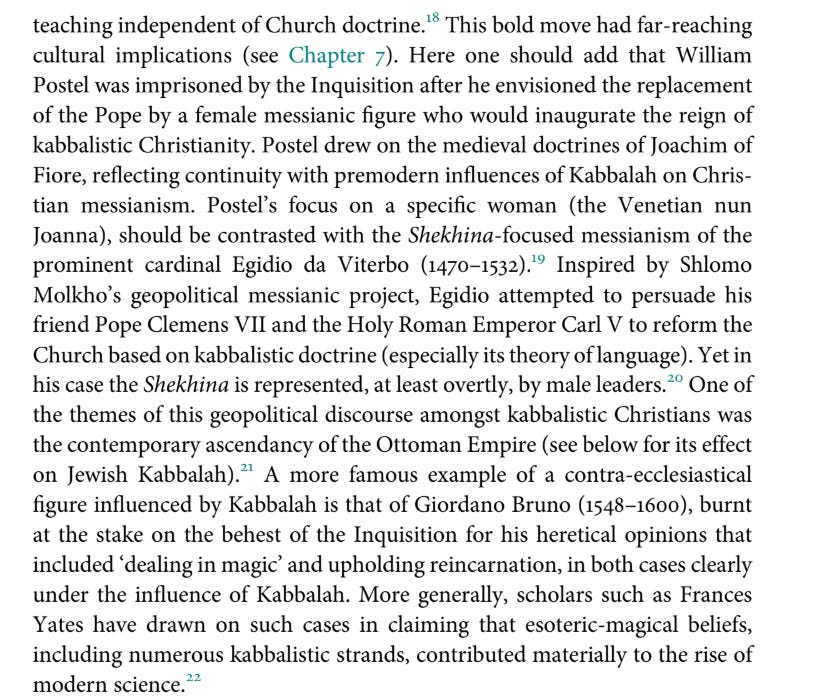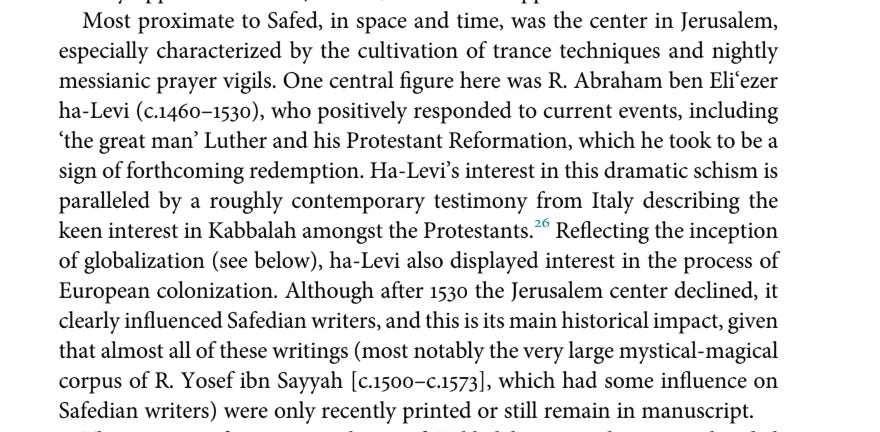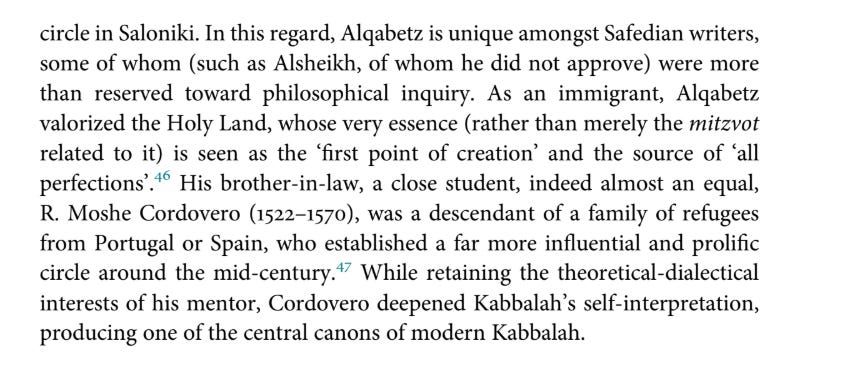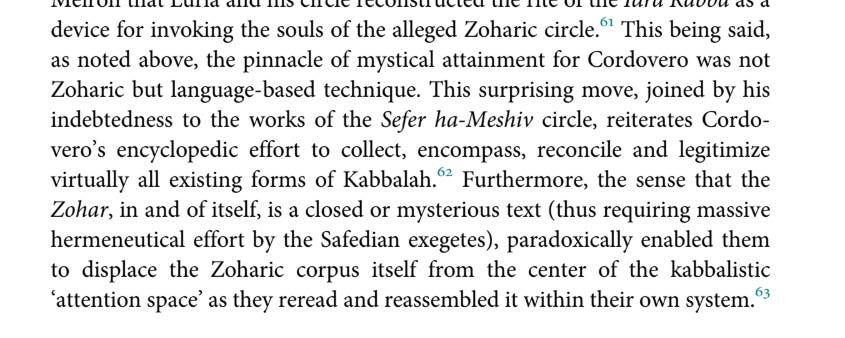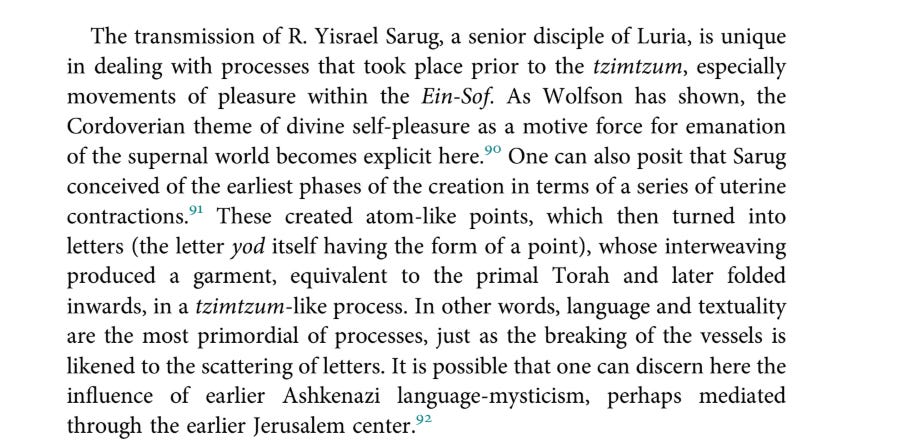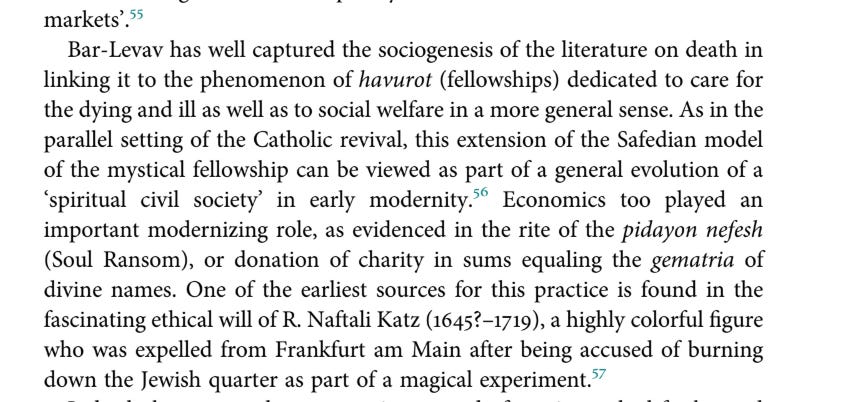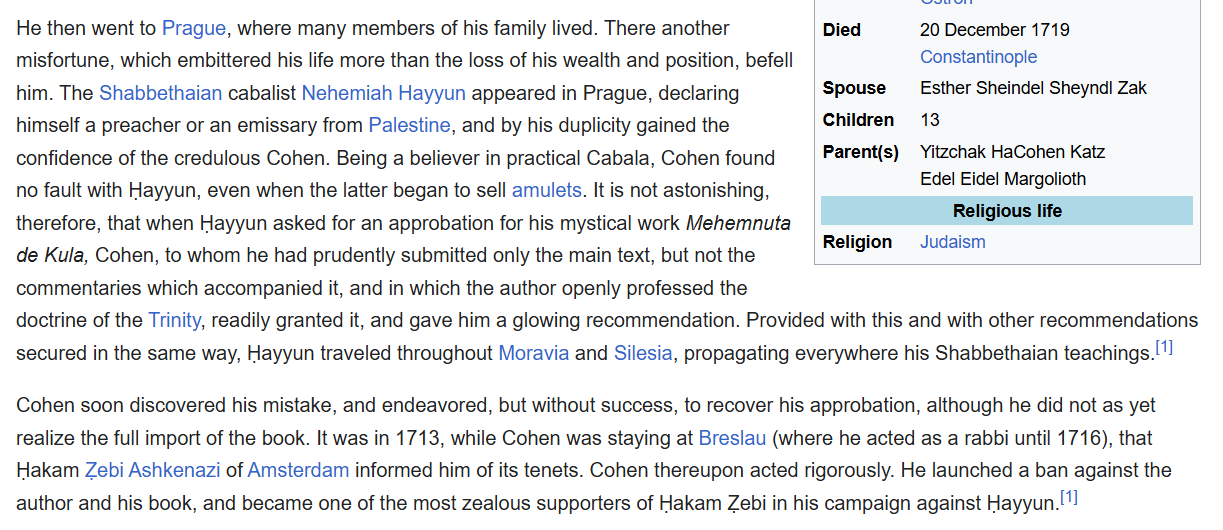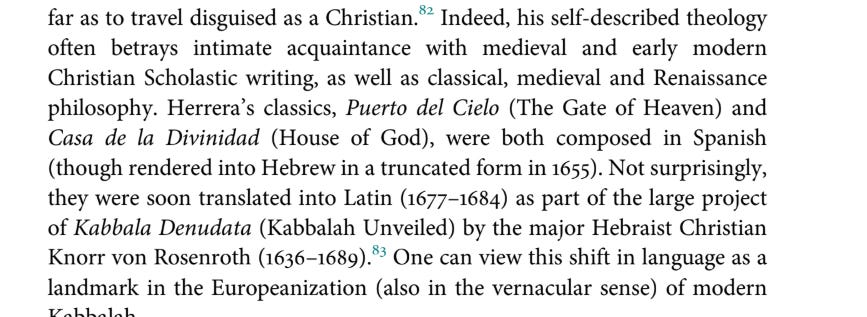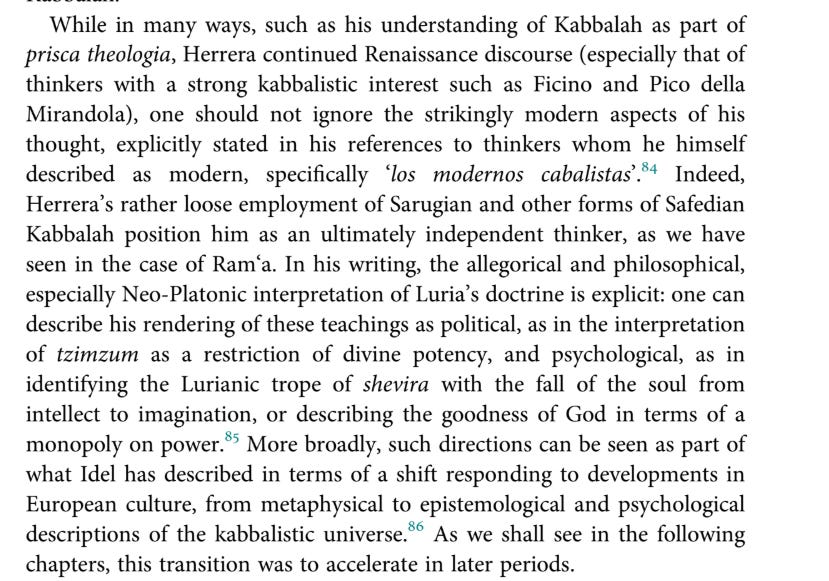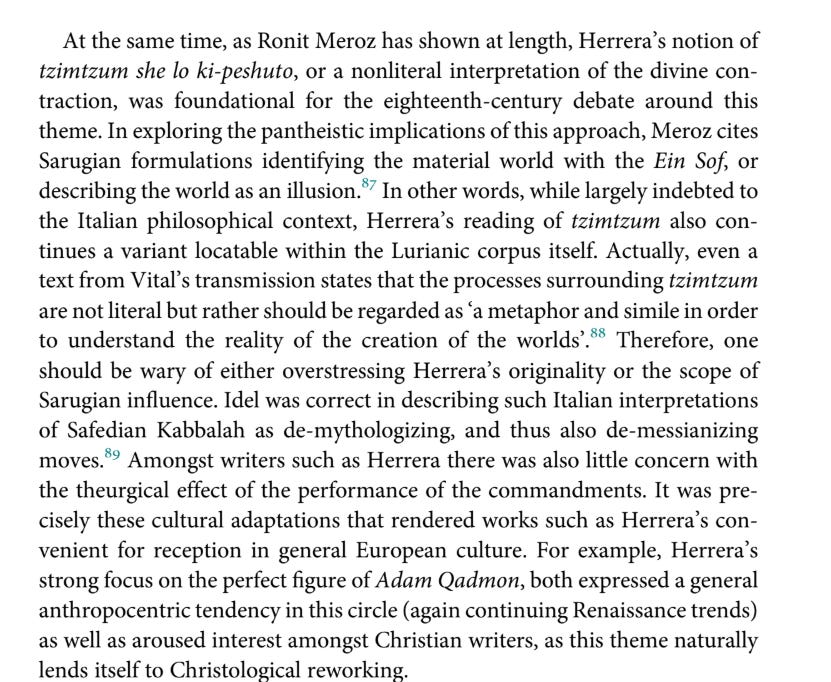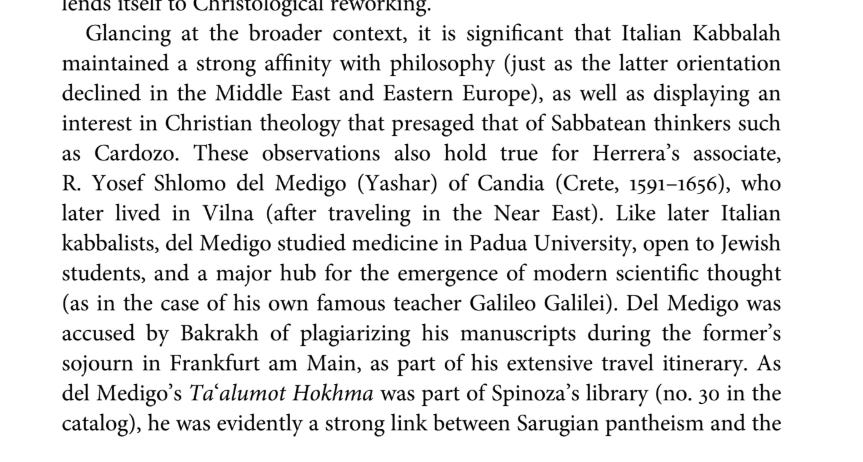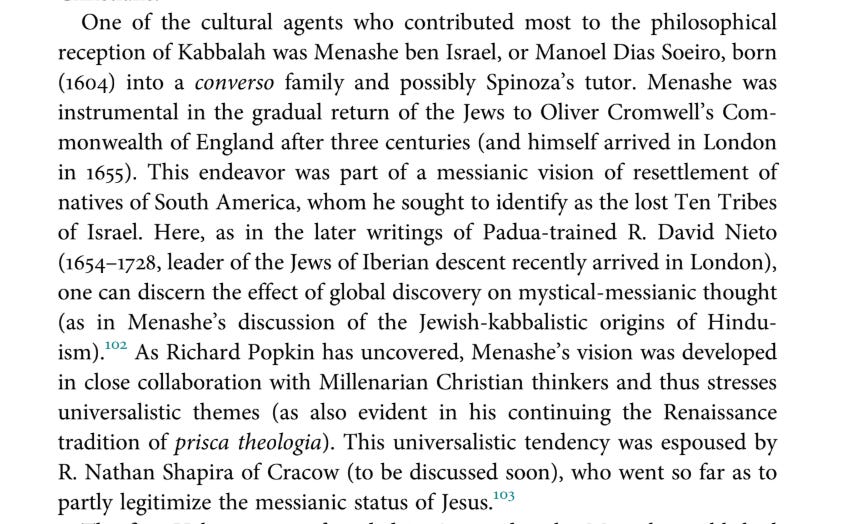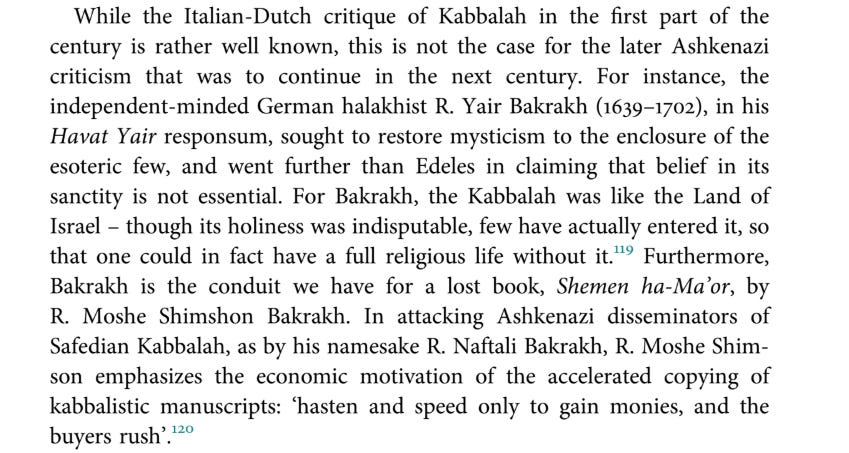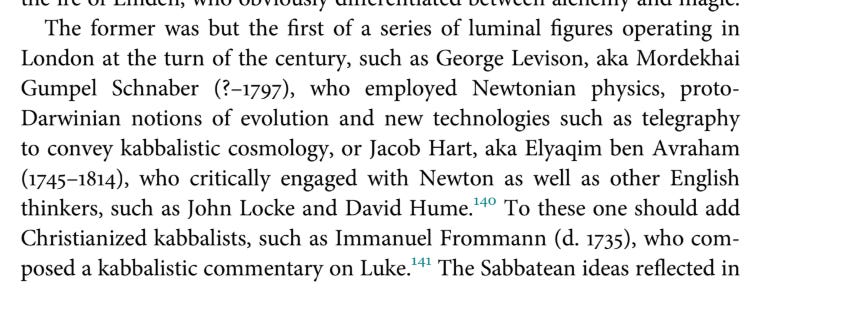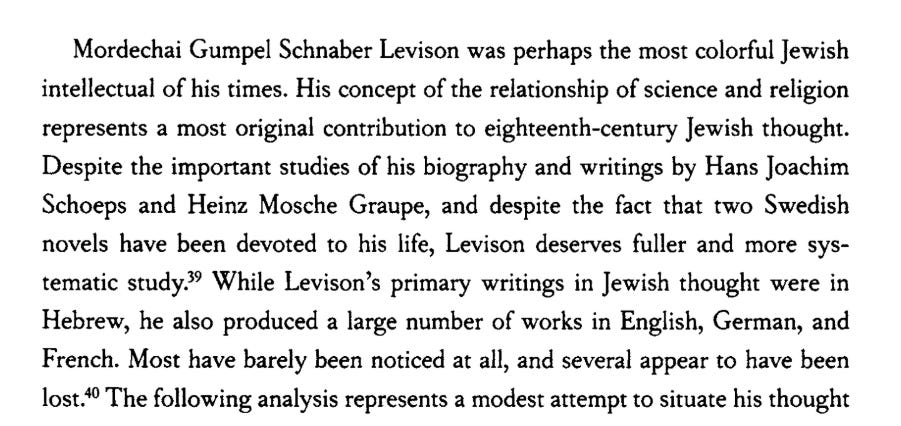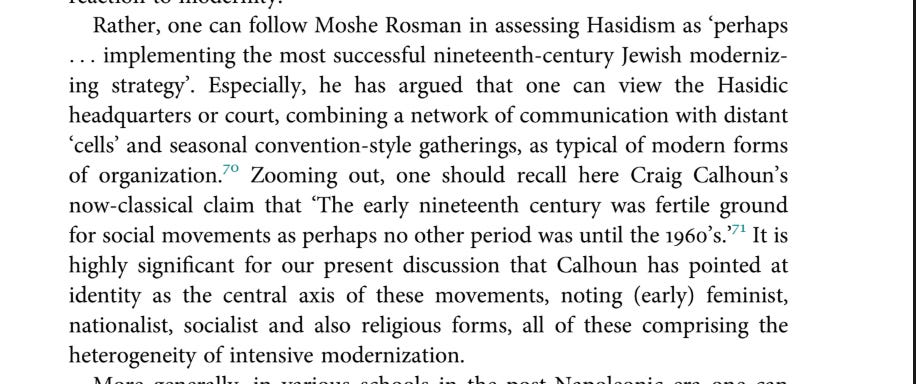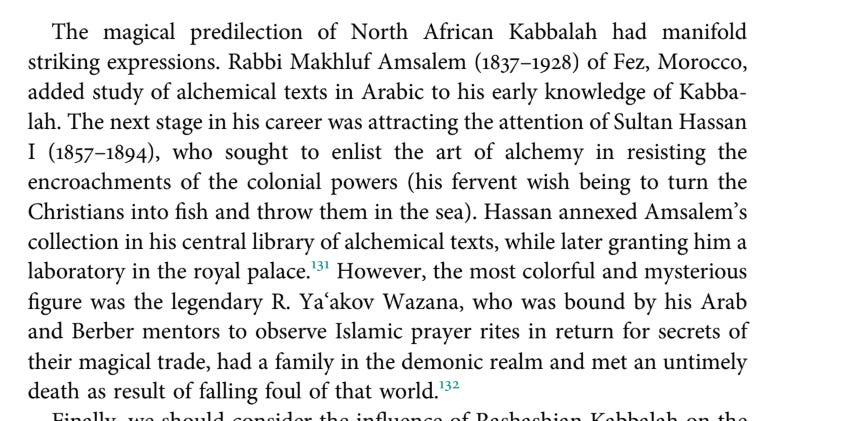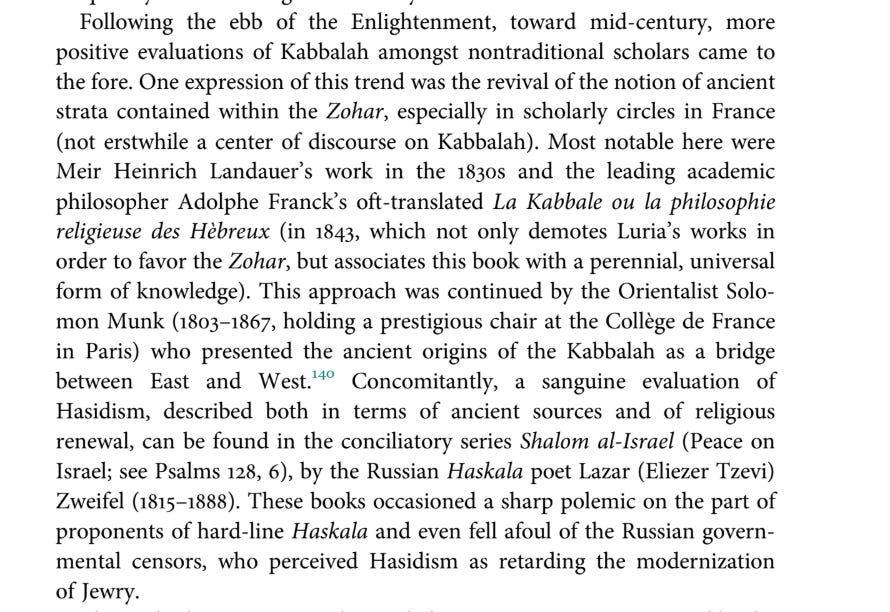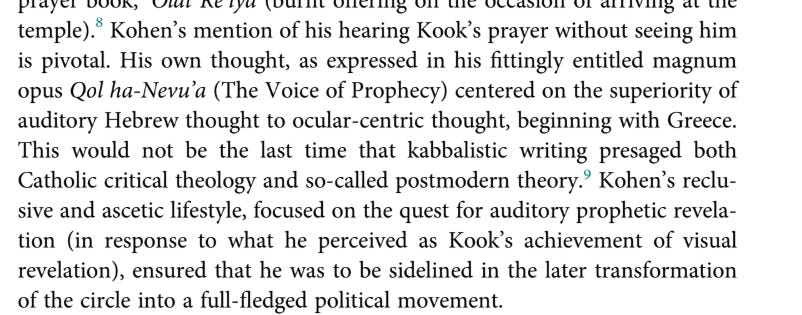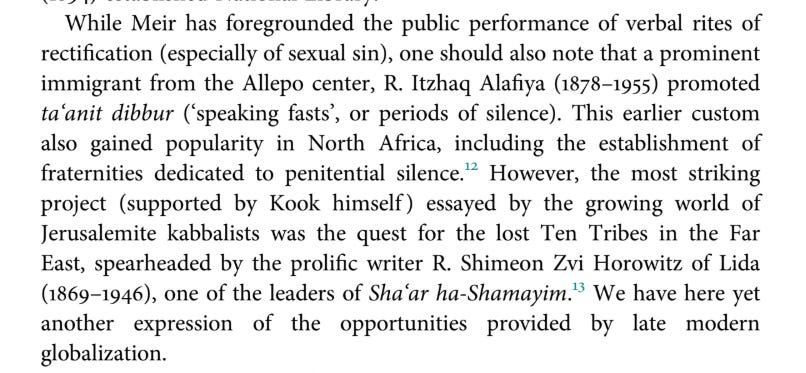Notes on Books I've Read: A History of Kabbalah from the Early Modern Period to the Present Day, by Jonathan Garb
Continuing the Series
Gonna now tackle a book I read more recently, which I will not type out again after typing it out for the title, even though it took me the same amount of keystrokes to say I won’t do it again, a problem I keep compounding.
Anyway, I really liked this book. After trying to dig my way through too much stuff on Kabbalah that was extremely densely written, which is fine, by the way, it’s a dense subject, it’s just that I’m reading this on a shabbos afternoon off my ADHD meds, Garb is very readable, and presents the information in the way I like my information presented, with a wide ranging survey that sprinkles in little fun facts to keep your attention. There’s a strong possibility a lot of the stuff I flagged are the little fun facts, but maybe I flagged some important stuff too. Because this is a survey, I’m going to be on purpose less focused and allow myself to follow up on stuff that intrigues me outside the book and go on little rabbit holes. Hopefully that will mean more fun for all involved. Let’s dive in.
page 33-34, starting off with some spicy Christian Cabala
So, interesting that kabbalah (or Cabala) was used as a way of rebelling against the church and even proposing feminine messianic figures. Also interesting to me that not just R. Yosef Karo couldn’t get Shlomo Molkho out of his head.
Going to Postel’s wikipedia page:
We see here one of the problems that happens when Christians get their hands on kabbalah, where they take ideas out of context to claim all religions share universal truths (maybe they do, maybe they don’t), and that Christianity best represents those common foundations (uh oh). This is I think a big idea in Judaism, that there is a danger to unchecked universalism that leads to just imposing your idea of truth on the whole world, a danger inherent in monotheism but balanced by Judaism’s particularism but unleashed in Christianity and Islam. But that’s just me and things I think, back to the book.
Really interesting guy I hadn’t heard of, R. Abraham ben Eliezer haLevi, who was gung-ho for the Protestant Reformation and interested in European colonization. The early modern period is very cool for how the world is shrinking during this time, and the fact we see a guy who was in touch with the goings-on in the world around him even while cultivating mystic techniques is a pretty fascinating data point. According to wikipedia, he is also one of the first rabbis we know of to have corresponded with Ethiopian Jews.
Also, pretty fun that he was, at least in this wording, in favor of Luther because he accepts the Catholic framing.
“This guy is going to destroy the Church!”
”Good.”
I mean, guy was expelled from Spain. I don’t blame him. But I’m assuming from the wording of wikipedia.
Anyway, here’s a doctoral dissertation on the guy.
Moving on.
Page 41
Not sure why I flagged this, but some guesses.
1. R. Shlomo Alkabetz was cool with philosophy?
2. He didn’t like R. Moshe Alshich?
Ramak was his brother-in-law?
But yes, Ramak is important, obviously.
page 44
This on the other hand, I understand what I found interesting. That the Zohar actually became less important to the Safedian Kabbalists because of how revered it was, that it became a closed/mysterious text that required interpretation, which meant that they had the freedom to interpret it according to their own ideas, that’s pretty cool. I like it when religious texts and thought is more flexible than people believe, and the idea that its the supposed inflexibility of a text that actually makes it much more malleable to interpretation is the kind of thing that outsiders rarely understand. It is also specifically in Kabbalah, where there is always a secret meaning to be mined by an elect, that this rhetorical move is most effective. We may get to this in a bit, but a thing that intrigued me in a different book is that one of the things the Arizal would do when other people would explain their kabbalistic system would say “yeah, that’s one level of the system, but I’m actually talking about a deeper level”, which is a neat way of winning an argument without dismissing the opposition entirely. (Apparently Moshe Halbertal’s book on Esotericism, “Concealment and Revelation” is about this, but I haven’t read it yet.)
Religions have ways to evolve on their own terms. People should understand that.
Moving on, page 53, though unfortunately skipping the whole section on the Ari and R. Chaim Vital’s transmission of the Ari’s ideas, but the point of this is not to sum up the book, it’s to talk about stuff that popped out to me.
So R. Yisrael Sarug is interesting because 99.9999% of what we have of the Ari’s Kabbalah is through R. Chaim Vital, who portrays himself in his works as the Ari’s foremost disciple, and that may be understating the relationship. But there’s some reason to question R. Vital’s self depiction of that relationship, and he seems to have it out for R. Sarug specifically in some texts (when I go through Lawrence Fine’s book on the Ari, we’ll talk more about that). So R. Sarug is sort of a suppressed path of Lurianic Kabbalah, and I am fascinated by stuff that didn’t make it into the books and the people and works forgotten by history for unsatisfying reasons. And there is some interesting stuff in here. Divine self-pleasure as motivation for emanation, uterine contractions, a bigger role for language, possible influence of earlier Ashkenazi sources, which we do know that the Ari had as well (remember what his last name was). The book goes on to talk about how R. Sarug had more of an influence than usually thought, especially in Italy, where he made contact before R. Vital. I do think it would be fun to pronounce oneself a Sarugian Lurianic Kabbalist who must purge it of all its Vitalian distortions, but that seems like a lot of work for a bit.
Going on to page 80, because either I didn’t find Safed very interesting (?!) or figured I’d read enough about it in Fine, we move on to the 17th century, where there is a Crisis in the form of Sabbateanism, which I apparently didn’t find too interesting either, and went to the developments in Lurianic Kabbalah and the “Finalization of the Safedian Canon”
OK and interesting thing and a fun thing. I’m always interested in “spiritual civil society” and the existence of fellowships and circles, as I think the hollowing out of civil society that’s described by Robert Putnam in “Bowling Alone” has happened in the religious world as well, and that we need more non-institutions of social bonding in the religious world, particularly the suburban Modern Orthodox. Part of why I’ve become so interested in kabbalah and chassidus is the ability of these movements to form such circles and fellowships that work outside the bounds of official institutions, especially when they do the kind of good works described here.
That said, lets talk about R. Naftali Katz. Anytime an academic text describes a guy as a “highly colorful figure”, you know you’re in for a treat. And what we have in this text is itself lots of fun, though only with the benefit of 300 years of distance. What kind of magical experiments, exactly, lead to burning down the Jewish quarter? Can you imagine being the guy who did that, and seeing everyone in your community mad at you because you were trying your hand at some Magick? Let’s see what else we can find about this guy on the interwebs.
First wikipedia, which seems to be relying on the public domain Jewish Encylopedia.
Their description of the fire is different and paints him a scapegoat of credulous masses, but I’m going to assume Garb has a more accurate understanding.
OK gives a haskamah on a Sabbatean work by Nechemiah Hayoun, the article basically calls him stupid, but eventually supports the Hakham Zvi’s ban against Hayoun.
Not sure whether this is necessarily accurate, reliant as it is on 120 year old scholarship, before even Scholem arrives on the scene. And I’m not seeing much color.
Apparently there’s a book?
If anyone has the book or knows more about this “highly colorful” character, chime in down in the comments!
Moving on to page 87, where it’s talking about one of R. Sarug’s students, R. Abraham HaKohen Herrera
So a bunch of interesting stuff here:
1. We have a cultured, urbane guy who knows what people are discussing in the universities, who is not only learning kabbalah but is seeing kabbalah as related to what he’s getting from culture.
2. His interpretation of Lurianic/Sarugian kabbalah is in line with his times, ie, 17th century Italy, and sees kabbalah as having significance beyond metaphysical, even seeing it as political, foreshadowing shifts in understanding kabbalah that would happen later. In fact the next paragraph talks about how Herrera’s non-literal understanding of tzimtzum is ahead of the debate on this topic between chassidim and misnadgim.
Herrera’s Wikipedia page has some fun stuff too.
its cool when worlds you know from studying history and from studying Jewish history collide and you realize its the same world that’s both bigger and smaller than you think.
Herrera seems cool, maybe we should learn him more.
Going on to the next paragraph, which I actually do have flagged.
So this guy has a bunch of interesting link ups with people better known than him. He was taught by Galileo and it’s cool that Padua University, which had such a strong Jewish presence throughout its history also was a major hub of the scientific revolution and that the same place did both. But his works are also in Spinoza’s library and may have influenced him. And there’s more cool stuff about Delmegido, including stuff that presaged modern science and debate as to whether he’s a kabbalist at all, but read the book yourself, I didn’t flag it. Italian Jewish history is so cool.
Moving on to page 91, to talk about Menashe ben Israel.
He’s another guy that has a lot of links to “regular” history, whether it’s his possible tutoring of Spinoza or his relationship with Cromwell and success in getting Jews to England, or being the subject of a Rembrandt painting. He also had a printing press which was hugely important in the Early Modern Period. Not sure why I flagged this paragraph though. ‘
moving on to page 96, talking about critics of Kabbalah
The Havot Yair is a fascinating guy worth reading up on. I recommend the “Jewish History with Rabbi Dr. Dovid Katz” episode on him.
Interesting that the criticism of kabbalah wasn’t necessarily its truth but its getting out to the masses.
Also interesting to see what pre-Zionism relationship with Eretz Yisrael was for a guy like the Havot Yair, who sees kabbalah as analogous to living in Eretz Yisrael. Is it holy? Sure. Do you need it? Nah. That sound you heard is your shana bet rebbe fainting.
Also interesting that Kabbalah books sold well. Something about kabbalah appealed to people to the point that printers noticed and kept up with demand. I think its important to ask what appealed to people. Was it merely showing it off in their shelf? Or were kabbalistic texts themselves the appeal and we should be asking questions about what those texts did that entranced their readers? I’ve seen this sentiment quoted in the name of Elliot Wolfson, whose works I generally don’t understand, that kabbalistic works should be analyzed not just for their content but for the mystical effect it has on the reader. This seems like the way forward for scholarship, at least to me, and should utilize what we know scientifically about flow and trance states. Melila Hellner-Eshed’s work has pioneered this, and there should be more that try to answer the question, why did this stuff catch on as well as it did?
Moving along, another 40 pages or so of stuff I didn’t flag until page 135, where we’re into the 18th century, where we find some weirdos.
Ok those guys sound weird, I’m in, lets go to the internet.
No wikipedia article on either.
Levisohn doesn’t have a wikipedia page, but he does have an OnTheMainLine post from Friend of the Stack Shimon Steinmetz. You should read that, because he does a better job than I’d do, and then pay Shimon money or something, so he can get the pictures back up in the post. I guess also ask him about Part II.
Hart doesn’t have much either. But there’s a footnote to “Jewish Thought and Scientific Discovery” by David Ruderman, page 332-370.
So let’s look at that.
Ok so Ruderman has a whole discussion of a bunch of guys including Levisohn and then says, essentially, Levisohn’s really interesting and no one’s written on him so I’m gonna do it.
If there’s demand I’ll do a separate post on what I find interesting in Ruderman’s account, but I want to keep moving.
Page 144, a joke!
page 158, and we’re fully talking about Chassidus now,
I’ll talk more about this when I unpack my notes on the Big Book O’ Hasidism I’m in the middle of, but this is a very important point when talking about the Hasidic movement, that it used modernity against itself, and that it is best understood as a modern social movement with all that entails. There’s a lot of interesting stuff about how Hasidism came out of but also accelerated the collapse of the Kahal system, particularly in Poland where the Vaad Arba Artzot being disbanded was key to the process. Also important is that Hasidism worked in terms of networks rather than communities, that were kept in contact with each through occasional meet ups, correspondences, and identification with a movement that transcended one’s communal identification.
Page 172.
Every line in this paragraph went somewhere I didn’t expect it to go. Awesome.
He cites a book about R. Wazana (Yoram Bilu’s “Without Bounds: The Life and Death of R. Yaakov Wazana”) that maybe I’ll read sometime.
page 174
Interesting that there was a trend towards positively evaluating kabbalah in the Romantic era, but still associated with universalizing tendencies because that’s what the academy does. And when it doesn’t, people get mad, like they did at Lazar Zweifel, who seems like a cool guy. Would love to read more about him but there doesn’t seem to be that much out there. If anyone knows more, chime in down in the comments.
Page 193, talking about one of my favorite guys, the Nazir.
Just your average Jewish philosophy academic who became an ascetic and took a nazirite vow in order to get prophecy whose idea of Judaism is one that privileges the auditory over the visual (a quote from his book is on the bulletin board outside my classroom). I plan to get a copy of Kol Hanevuah this summer, and hopefully learn it sometime.
Page 194, talking about Kabbalists in Yerushalayim in the 20th century.
Tell me more right now about a kabbalist in the Far East looking for Ten Lost Tribes. Why isn’t this a tv show? He cites Yonatan Meir’s “Kabbalistic Circles in Jerusalem” so let’s go take a look at it.
Keep reading with a 7-day free trial
Subscribe to Secondary Elite: A Misfit Torah Newsletter to keep reading this post and get 7 days of free access to the full post archives.



